New research shows that while many cloth and medical masks fall short against tiny airborne particles, simple hacks like overmasking or using braces can dramatically improve your protection, yet only N95 and CaN99s respirators consistently keep you safest. Study: Measuring the fitted filtration efficiency of cloth masks, medical masks and respirators . Image Credit: Boumen Japet / Shutterstock A recent PLOS ONE study investigated the efficiency of medical and non-medical masks and respirators in filtering out small aerosols.
Importance of face masks Aerosol transmission of severe acute respiratory syndrome coronavirus 2 (SARS-CoV-2), the causative agent of the coronavirus disease 2019 (COVID-19) pandemic, is well-documented. Every individual was recommended to wear face masks during the pandemic to stop the viral spread. During the pandemic, the global shortage of personal protective equipment (PPE) led the general public to use cloth masks as an alternative.

In July 2024, the World Health Organization (WHO) recommended that everyone wear masks regularly in public settings. Currently, a wide range of masks and respirators is commercially available, including home-sewn and commercially produced cloth masks, certified medical and non-certified disposable masks, as well as KN95/KF94s and N95/CN99s. It is important to systematically assess the aerosol filtration capacity of different masks and respirators, particularly from the wearer's perspective.
This knowledge would be invaluable for public health advice on preventing airborne diseases. About the study The current study recruited participants between March 2021 and April 2022. All participants were above 16 years of age, and none had a history of respiratory diseases or were allergic to latex.
All participants’ facial measurements were collected according to the US National Institute for Occupational Safety and Health (NIOSH) Bivariate Panel. Importantly, the study focused on one specific, consensus-designed cloth mask—the Essex mask—which was developed and optimized by a panel of community experts. Results for cloth masks, therefore, reflect this carefully designed model and may not generalize to all cloth masks.
Level 1 masks (Polar Bear and O2), level 3 masks (Halyard and Primed), two-layer pleated cotton cloth masks without a nose wire (Essex mask), non-certified masks (e.g., KN95s, KF94s), and respirators, including 3M N95 Aura 1870+ and Vitacore CaN99, were compared to assess their aerosol filtering capacity.
A TSI 8026 Particle Generator was used to measure aerosols. The CSA-Z94.4-2002 protocol was used to detect the filtering capacity of particles in the range of 0.
02–1 μm. Participants rated each mask based on a subjective leak, glasses fogging, and discomfort using Likert scales. Filtration efficiency of over-masking, i.
e., use of an Essex mask on earloops, in addition to a level 1 and 3 certified mask as the base mask, was assessed. It is also important to note that the study assessed filtration efficiency from the perspective of wearer protection, not source control.
Study findings A total of 12 participants between 21 and 55 years of age were recruited. This cohort included 58% of females, and 25% were non-European. The filtration efficiency of a two-layered cotton pleated Essex mask was found to be 47 ± 5% when worn on earloops and 55 ± 6% on overhead ties.
These values were comparable to the filtration efficiency of level 1 masks at 52 ± 6% (earloops) and 56 ± 9% (overhead ties). Level 3 masks exhibited variable filtration, with one mask at 60 ± 6% and another at 75 ± 10%. KF94, KN95s, and the KN95-lookalike mask filtered between 57% and 77%.
Certified respirators exhibited the highest filtering efficiency of all masks at 97–98%. The median filtration efficiency of the level 1 and 3 masks did not show further improvement after minor modifications, including wearing a scrub cap, ear guards, or knot-and-tuck. However, both masks improved after braces were implemented to boost the edge seal.
In contrast to the neoprene brace, the silicone and Fix-The-Mask braces in level 1 masks exhibited a filtering efficiency of 79–87%. Notably, all tested braces in level 3 masks yielded a median fitted filtration efficiency (FFE) of 92–94%. Over-masking did not influence leak scores, but mask type did.
Discomfort scores differed across mask/respirator types, ranging from 2 (comfortable) to 6 (uncomfortable). Medical masks and respirators were more comfortable than KF94 and KN95. Comfort scores were unrelated to fitted filtration efficiency.
Fitted filtration efficiency was significantly related to the subjective assessment of glasses fogging and mask leaks, with the latter being the stronger predictor, explaining 22% of fitted filtration efficiency. In contrast, glass fogging explained only 4% of the variation. In masks with no detected leaks, the mean ± SD filtration efficiencies were 86 ± 12%.
The means reduced as the leakage increased; however, these observations depended on mask type. For KF94s and KN95s, participants found it difficult to detect leaks, and perceived leak scores explained only a small proportion of the performance differences for these types. Mask performance was much more strongly predicted by perceived leak scores for level 1 and 3 masks with and without hacks.
For level 1 masks, the FFE values varied by 51% across individual trials. As much as half of the total variation in FFE scores for level 3 masks was explained by leak scores. All respirators were assigned the best-perceived leak scores of 1.
This mask type also exhibited the least variation in performance among mask types. No association was noted between menton-sellion length and the facial distances, bizygomatic distance, measured using a cord that traversed the tip of the nose and the bridge of the nose, respectively. Notably, N95 and CaN99 respirators performed at or near occupational health and safety standards for fit-tested personal protective equipment, even without formal fit-testing.
With proper fit-testing, their performance could be even higher. This study is among the largest to systematically compare mask modifications ("hacks") and overmasking strategies in real-world conditions, providing greater statistical power and generalizability than most previous studies. Conclusions It was noted that well-designed cloth masks offered fitted filtration for submicron aerosols in a similar range as level 1 masks: around 50%.
KN95s/KF94s and level 3 masks filter around 70%. Over-masking with a cloth mask on ties or external braces resulted in filtration of around 90%, compared to level 1 masks. Only N95s and CaN99s performed close to the occupational health and safety standards.
The findings specifically address wearer protection, and may not apply to source control or all possible mask designs. Tomkins, A. A.
, Dulai, G., Dulai, R., Rassenberg, S.
, Lawless, D., Laengert, S., Rudman, R.
S., Hasan, S., Drouillard, K.
G., & Clase, C. M.
(2025). Measuring the fitted filtration efficiency of cloth masks, medical masks, and respirators. PLOS ONE , 20(4), e0301310.
DOI: 10.1371/journal.pone.
0301310, https://journals.plos.org/plosone/article?id=10.
1371/journal.pone.0301310.
Health

Study reveals cloth masks rival some medical masks, but only N95s deliver near-total protection

A PLOS ONE study tested the real-world filtration efficiency of cloth masks, medical masks, and respirators, revealing large differences in performance based on fit and mask type. Only N95s and CaN99s approached occupational safety standards without formal fit-testing.















